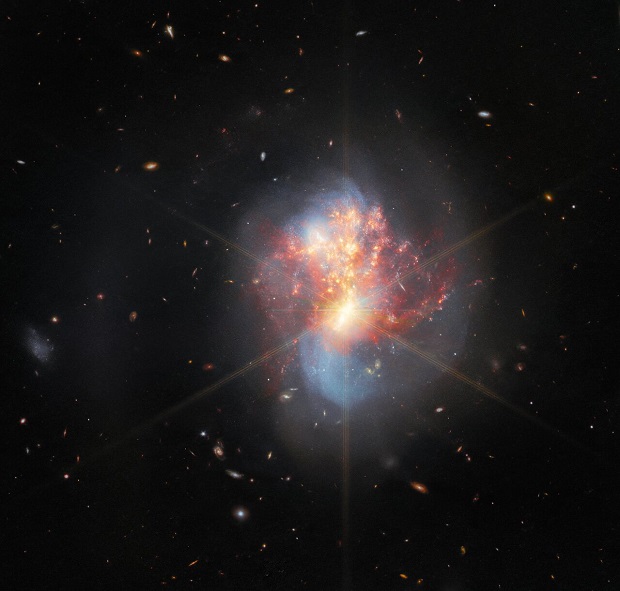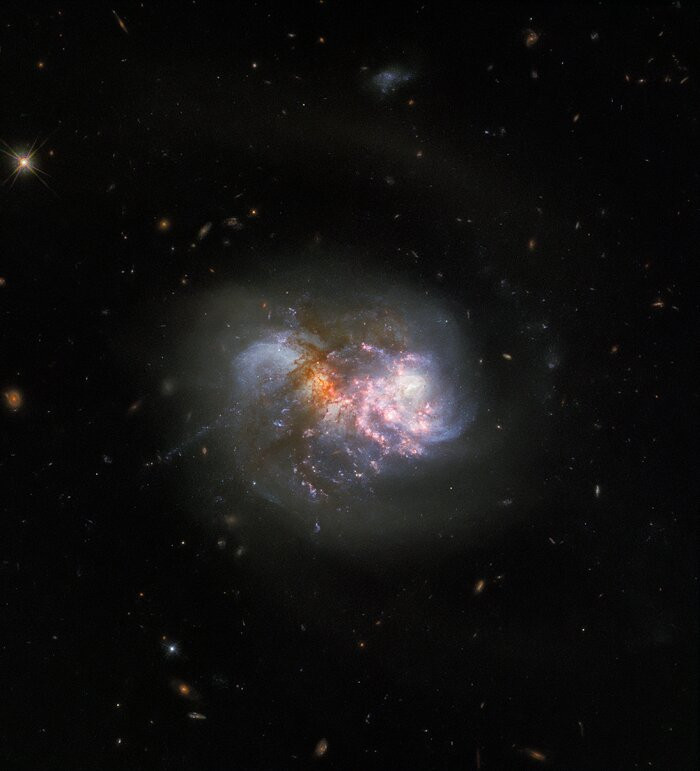
James Webb Telescope captures stunning image of merging galaxies
The James Webb Space Telescope took a stunning photo of the object known as IC 1623. The latter is a pair of interlaced and merging galaxies located in the constellation Cetus, about 270 million light-years from Earth.
The process seen in the photo is called the merger of galaxies. In IC 1623, two galaxies are sinking into each other, and their collision is expected to trigger a violent wave of star formation, resulting in the formation of new stars.

Because this pair of galaxies is well visible in the infrared spectrum, it could be an ideal target for imaging with the Webb Space Telescope. The team of astronomers was able to image IC 1623 in the infrared part of the electromagnetic spectrum using the Webb telescope's three advanced science instruments: MIRI, NIRSpec, and NIRCam. This photo shows the unprecedented capabilities of the Webb telescope, which can help study the complex interactions in galactic ecosystems.
In 2021, the Hubble Space Telescope also photographed the object IC 1623 (photo below). Here, above the galaxies, you can see orange and brown circles; it is actually dust beyond which the Hubble, unlike the Webb telescope, cannot "see."

If we compare the two images, we can see that the dark brown areas are much brighter in the photo taken by the Webb telescope, and the background galaxies, which also appeared in the frame, are seen better.
The new photo also shows refracted rays, which do not actually exist, and they appeared in the frame due to the structural features of the Webb telescope. These rays appear in the frame as a result of light refraction, which occurs due to the parts holding the secondary mirror and slightly disrupts its structure in the resulting image. Such rays can also appear in the images of other telescopes, including Hubble.
- Related News
- The end of the Universe: 3 plausible theories of a global apocalypse
- Mutated bacteria resistant to drugs found on the ISS: What does this mean and why is it a problem?
- 4 flares erupted from Sun in rare event: the Earth may be hit by geomagnetic storm (video)
- 11 incredible satellite photos published on Earth Day
- NASA shows all of Ingenuity's flight trajectories in one video
- Could life exist on Saturn's moon Enceladus?
- Most read
month
week
day
- Once in a lifetime phenomenon: This year we will observe a star explosion that occurred 3,000 years ago 916
- Google fires 28 employees who protested against company's cooperation with Israel 820
- iPhone 17 Plus will have smaller screen 791
- 5 best smartphones with IPS screens 763
- How DNA analysis helps to solve crimes and who can sell your DNA data and why: Interview with former FBI scientist Bruce Budowle 753
- Huge battery, IP68/IP69K and MIL-STD-810H certifications: Ulefone will present the Armor Pad 3 Pro tablet (photo) 736
- Sentry Enterprise presents first bank card with screen: How does it work? 618
- 5 original buildings with curious optical illusions (photos) 602
- What risks do crypto and digital currencies pose? Interview with Rasmus Nielsen 591
- How will new technologies change future of finance? Interview with director of Apricot Capital (video) 580
- Archive
